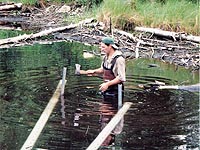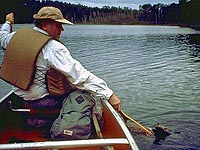| Approvals | Habitat Evaluations | Habitat Modifications | Stock | Stocking | Monitoring | Discussions |
 |
The creation of new brook trout fisheries typically requires regulatory approval, a process that can follow environmental assessment protocols at both the federal and/or provincial levels depending upon the fisheries being established and any modifications of the receiving environments. Our extensive experience with regulatory approvals with the provincial Natural Resource biologists as well as staff with the Department of Fisheries and Oceans and Environment Canada can minimize efforts and costs to obtain permission to stock trout in new waters and habitats. Furthermore, the new technology utilized by the company can result in stocking permission in cases were more traditional stocking protocols fail - because of risks to the genetic integrity of the receivers. |
| Back to Top |
| Approvals | Habitat Evaluations | Habitat Modifications | Stock | Stocking | Monitoring | Discussions |
Good habitat plays a key role in creating trophy brook trout fisheries. We use published protocols as guidelines to determining the potential for trophy brook trout development. Such guidelines include "Habitat Suitability Index Models" by the U.S. Fish and Wildlife Service, "Manual of Instructions, Aquatic Habitat Inventory Surveys" by the Ontario Ministry of Natural Resources, "Water Management Policies, Guidelines, and Provincial Water Quality Objectives" by the Ontario Ministry of the Environment. Typically, well oxygenated and cool waters are most desired along with an absence of predators, and a good food supply.
| Back to Top |
| Approvals | Habitat Evaluations | Habitat Modifications | Stock | Stocking | Monitoring | Discussions |
 Modifications to existing environments can improve fisheries. In fact many of the better trout waters in North America today are "managed" or "beneficially" impacted to various degrees by man's intervention. Some examples include (a) reservoir drawdown of hypolimnetic (cold) waters during hot summer periods (b) nutrient additions, sometimes indirect such as treated sewage and (c) food base additions, such as freshwater shrimp. Habitat evaluations on various waters from time to time reveal less than ideal conditions for good growth and survival of brook trout. Increasingly we are finding that modifications to these marginal or barren waters can turn poor environments into outstanding producers of big trout, sometimes at surprisingly modest costs. Evidence that marginal waters can produce big fish is found here. The 8.5 lb. brook trout shown to the right came from waters deemed unsuitable for stocking brook trout according to criteria from the Ontario Ministry of Natural resources. Nor did the habitat meet the Ontario Ministry of the Environment requirements for the protection of cold water fisheries.
Modifications to existing environments can improve fisheries. In fact many of the better trout waters in North America today are "managed" or "beneficially" impacted to various degrees by man's intervention. Some examples include (a) reservoir drawdown of hypolimnetic (cold) waters during hot summer periods (b) nutrient additions, sometimes indirect such as treated sewage and (c) food base additions, such as freshwater shrimp. Habitat evaluations on various waters from time to time reveal less than ideal conditions for good growth and survival of brook trout. Increasingly we are finding that modifications to these marginal or barren waters can turn poor environments into outstanding producers of big trout, sometimes at surprisingly modest costs. Evidence that marginal waters can produce big fish is found here. The 8.5 lb. brook trout shown to the right came from waters deemed unsuitable for stocking brook trout according to criteria from the Ontario Ministry of Natural resources. Nor did the habitat meet the Ontario Ministry of the Environment requirements for the protection of cold water fisheries.
The company is developing/utilizing habitat improvement tools to extend the environments that can support stocked trout on a year round basis. In many northern lakes winterkill is the only factor limiting trophy trout viability. This condition develops in late winter when dissolved oxygen levels decrease to toxic levels. Most remedial measures for overcoming winterkill involve whole lake aeration methodologies which can be expensive. We are experimenting with alternate methods for overcoming this limitation.
Our measures are aimed more at establishing refuge where trout can successfully survive adverse dissolved oxygen concentrations that are found elsewhere in the lake. One measure involving watershed management is particularly encouraging as we brought brook trout through some of the worst winterkill conditions on record - conditions that may only occur once in a hundred years or more.
Another example of habitat improvement involves the withdrawal and aeration from the hypolimnion of an upstream lake in summer to provide suitable temperature conditions in the downstream receiver.
| Back to Top |
| Approvals | Habitat Evaluations | Habitat Modifications | Stock | Stocking | Monitoring | Discussions |
 |
Stock - a most critical component. We start with the genes of the world record brook trout strain - Lake Nipigon - and then hybridize, sterilize, and monosex these fish to provide the right stock for the right purpose. As part of this technology DAMSA has sterilized brook trout three different ways. One method is new to the scientific community. Rainbow trout have also been sterilized. Finally brook and rainbow trout have been monosexed to produce all female or all male populations. The ability to determine fish sex has important implications for stocking fish. Where these species are absent, monosex or sterile fish can be stocked without risk to the integrity of the fish communities and ecosystems because they can not reproduce. And where these species are present, the addition of sterile fish can not dilute or alter the gene pool of existing stocks. For these reasons it is now possible to safely increase the number of waters holding brook and/or rainbow trout. |
| Back to Top |
| Approvals | Habitat Evaluations | Habitat Modifications | Stock | Stocking | Monitoring | Discussions |
Stocking size and numbers receives considerable attention as these factors are critical to the average size of your trophy fish in wild waters. Natural mortality, predation, emigration and food supply are all factors which have to be considered. Frequently trout are stocked by vehicle, sometimes by plane or even a helicopter.
| Back to Top |
| Approvals | Habitat Evaluations | Habitat Modifications | Stock | Stocking | Monitoring | Discussions |
How big do they grow? Monitoring growth, performance and longevity of your brook trout is exciting. Some simple protocols can go a long way to answering some basic questions. Catch and release programs for marked fish are emphasized. Fish can be weighed without even being touched by human hands. |
 |
| Back to Top |
| Approvals | Habitat Evaluations | Habitat Modifications | Stock | Stocking | Monitoring | Discussions |
Our services include discussions of:
| Back to Top |